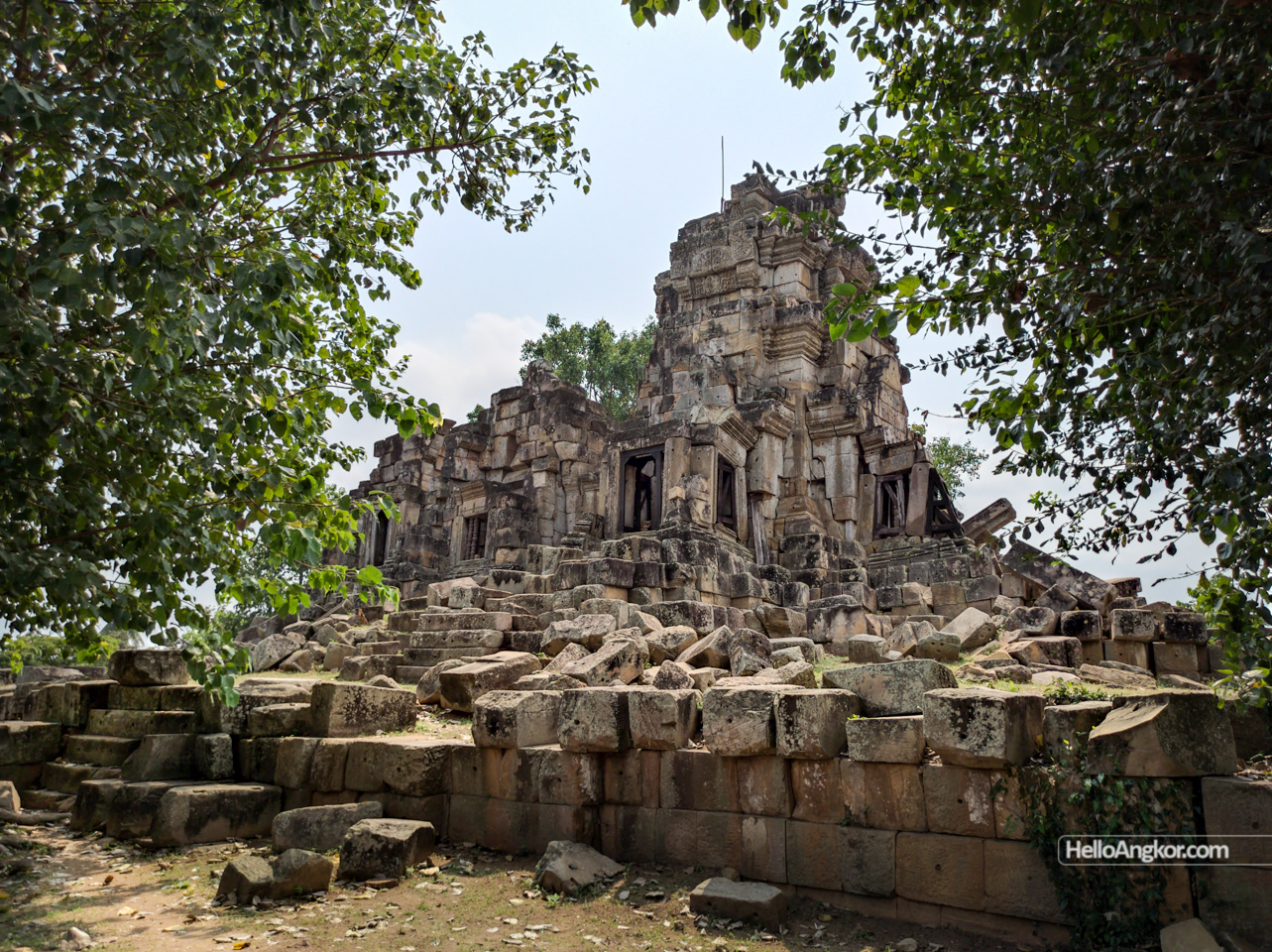- Area: Battambang Province > Aek Phnum District > Peam Aek Commune > Ta Korm Village
- | Type: Ancient Remains & Temples
Wat Ek Phnom, or Ek Phnom Pagoda, is located 8 km north of Battambang city featuring the remains of an 11th-century ancient temple fronted by a contemporary pagoda that also features a giant Buddha statue.
The ancient temple, part in ruin, is a square sandstone shrine with a “library” building enclosed by an outer wall with entrance gopuras on the east and south side. All of which is atop a raised laterite base on a rise that was then surrounded by a moat.
The site features several extraordinary lintels and pediments. One depicts the famous Churning of the Sea of Milk scene which is topped by a pediment featuring Brahma atop a lotus that emanates from a tree no less, of course, there are plenty of onlooking worshippers. Another pediment depicts Vishnu in his cosmic sleep giving birth to Brahma below which is a lintel that is assumed to be a dancing Shiva atop of Kala. Another lintel, in a fantastic state of preservation, depicts what may be Krishna fighting off two half-horse half-lion figures. Yet another intact lintel depicts a more common Indra atop a tri-headed Airvata (Elephant). Fragments of other lintels can be seen around the site.

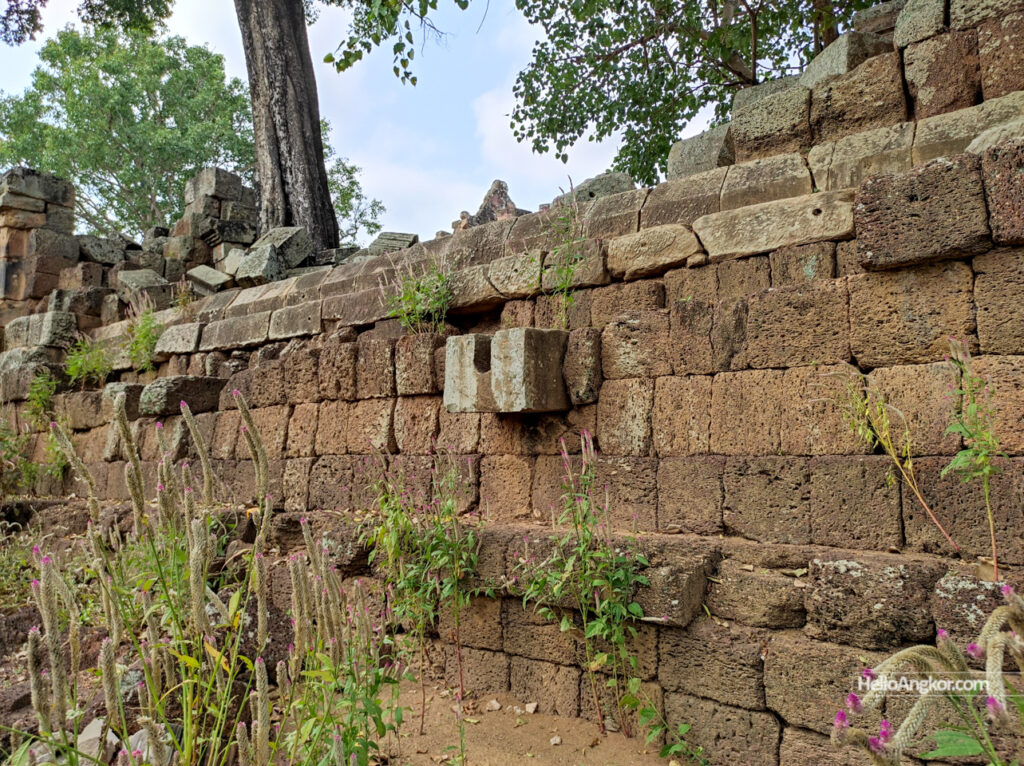



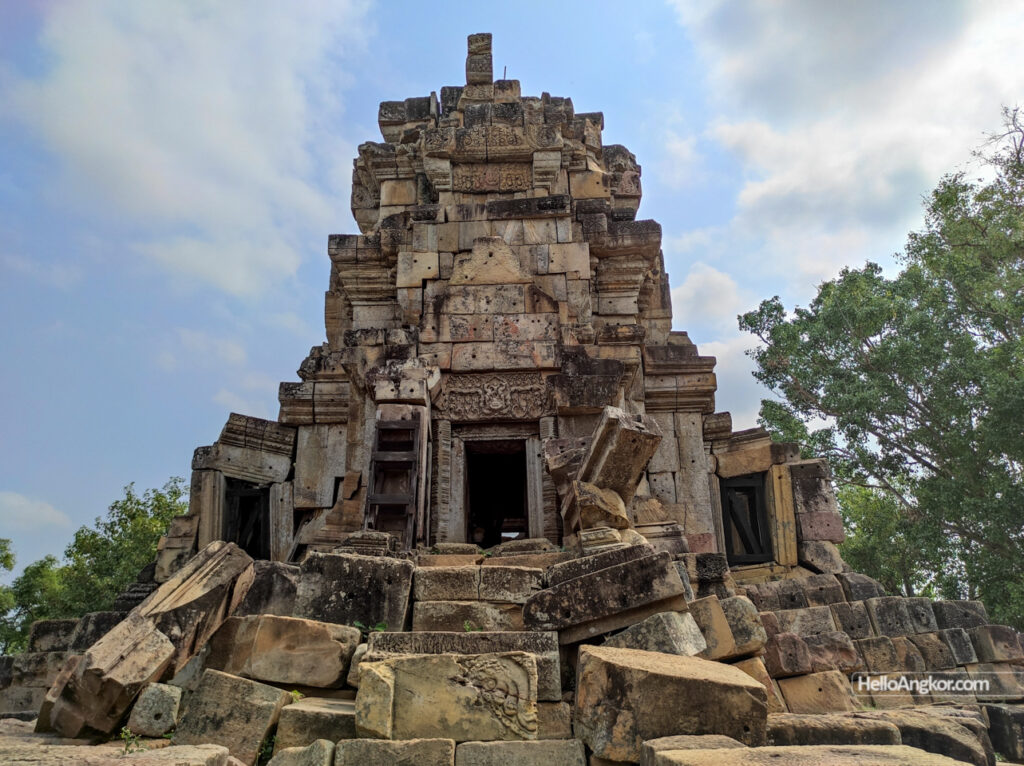
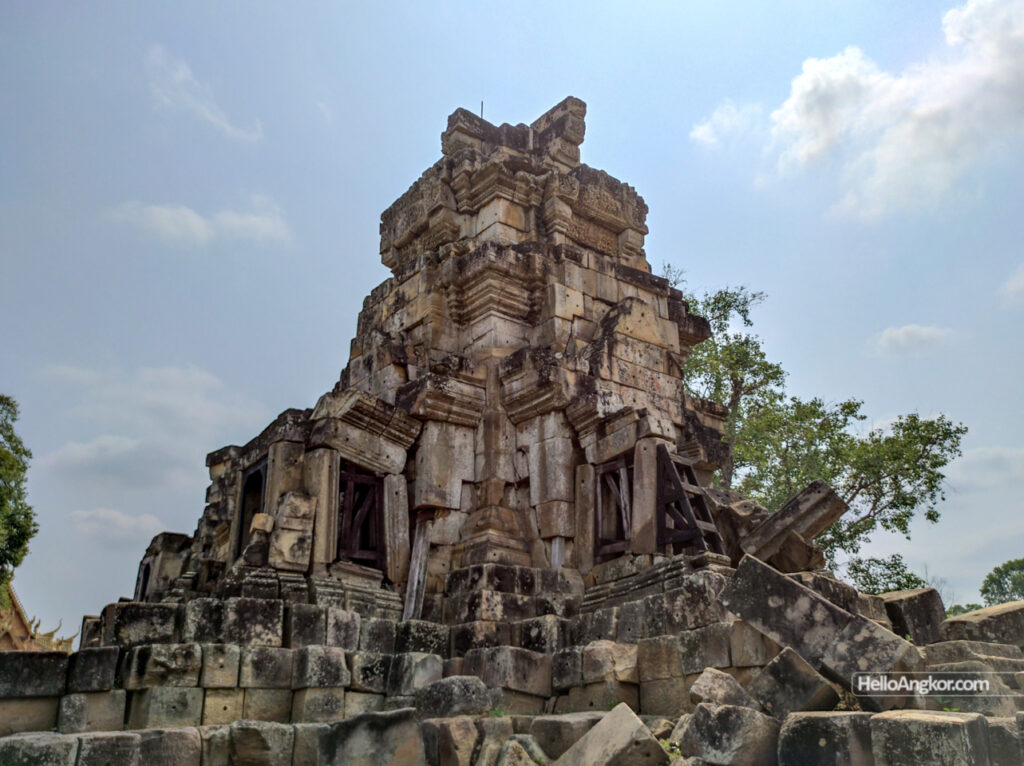
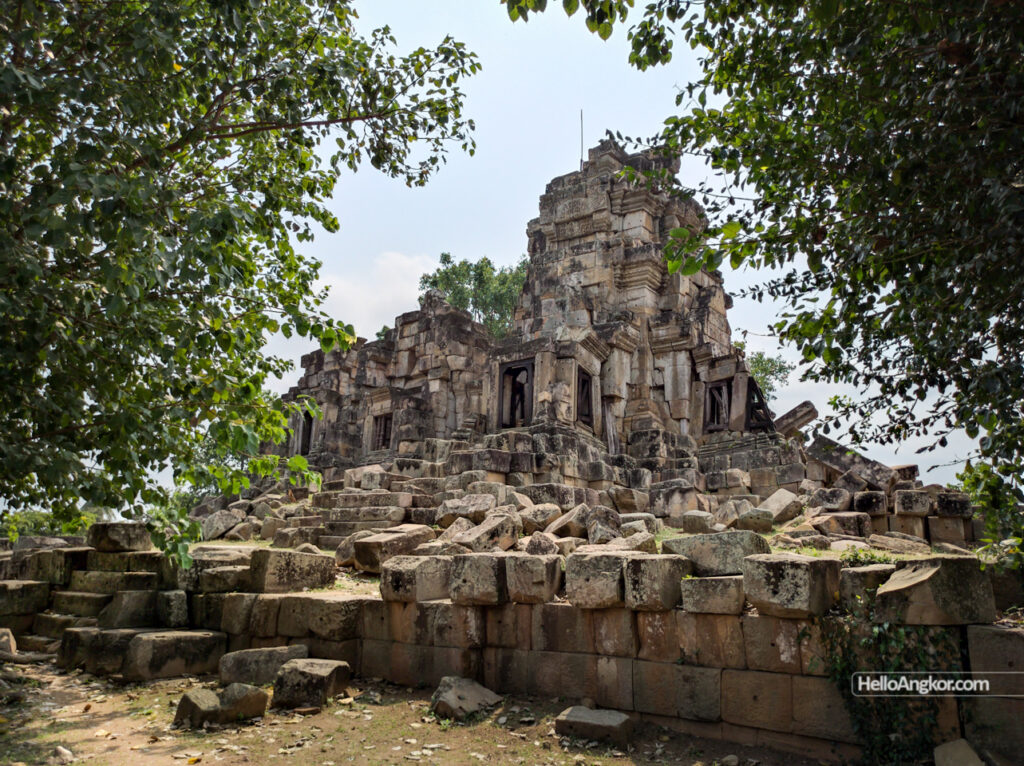
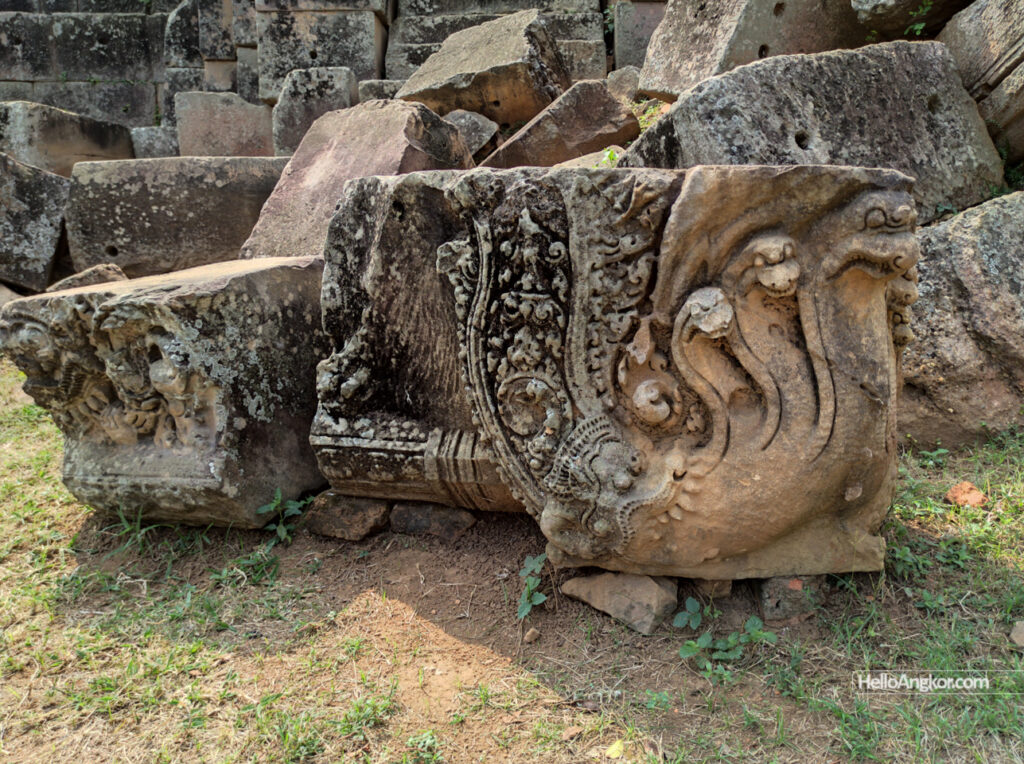

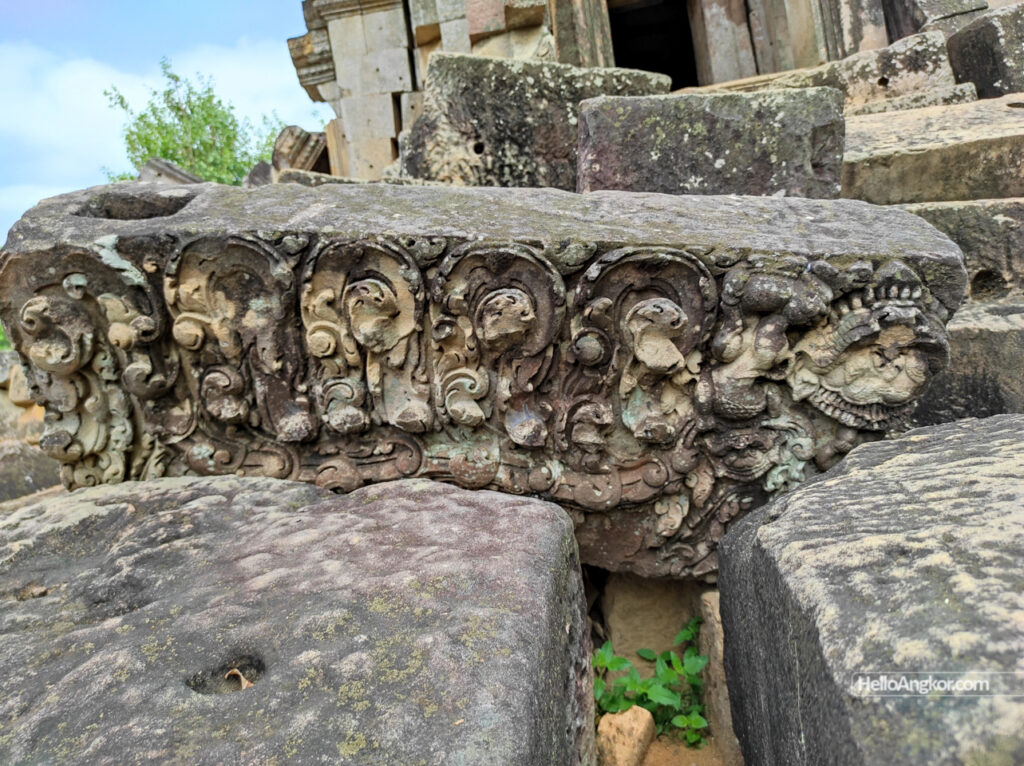


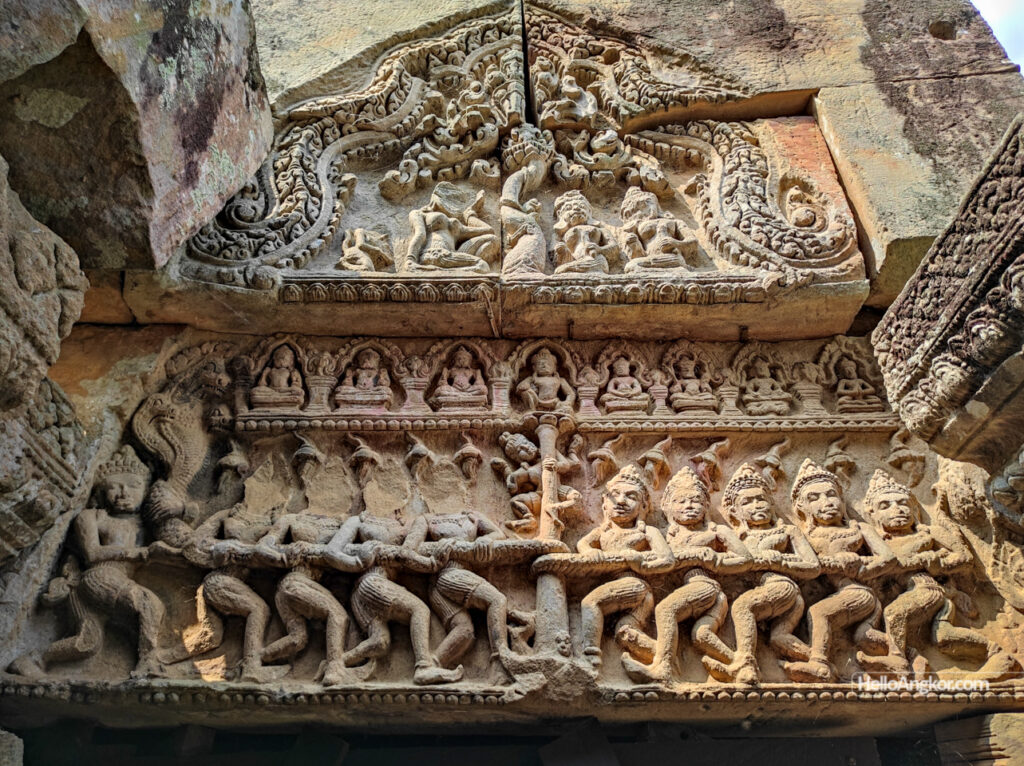
In front of the ancient site, on the eastern side is a contemporary pagoda and a giant Buddha statue.
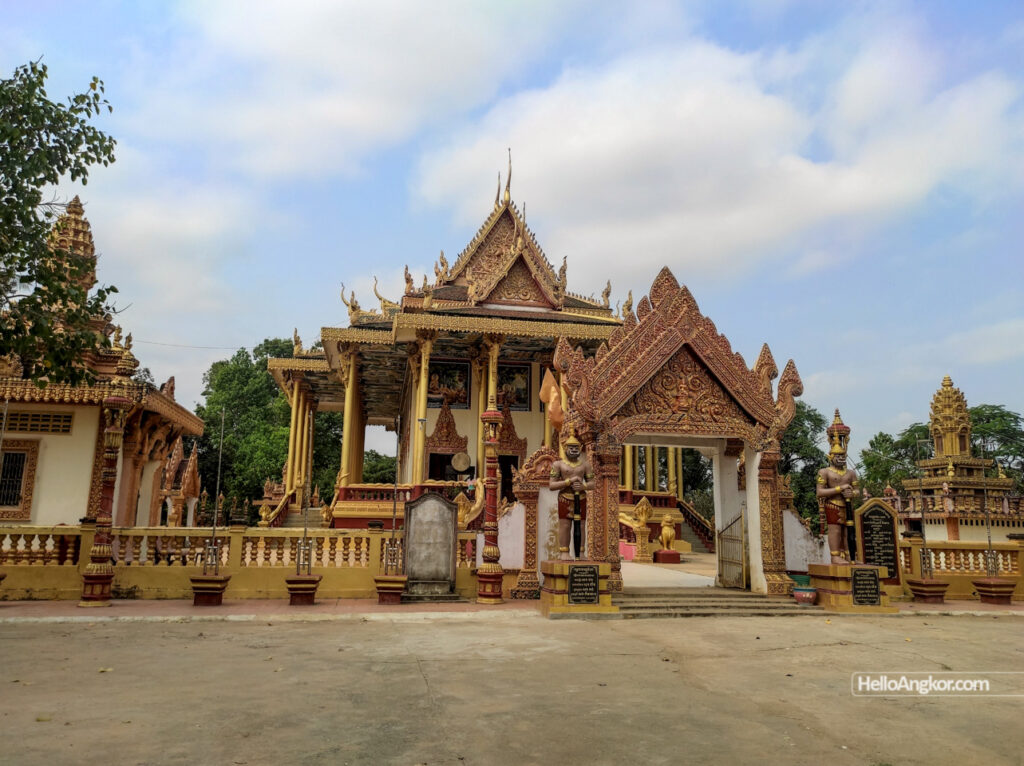
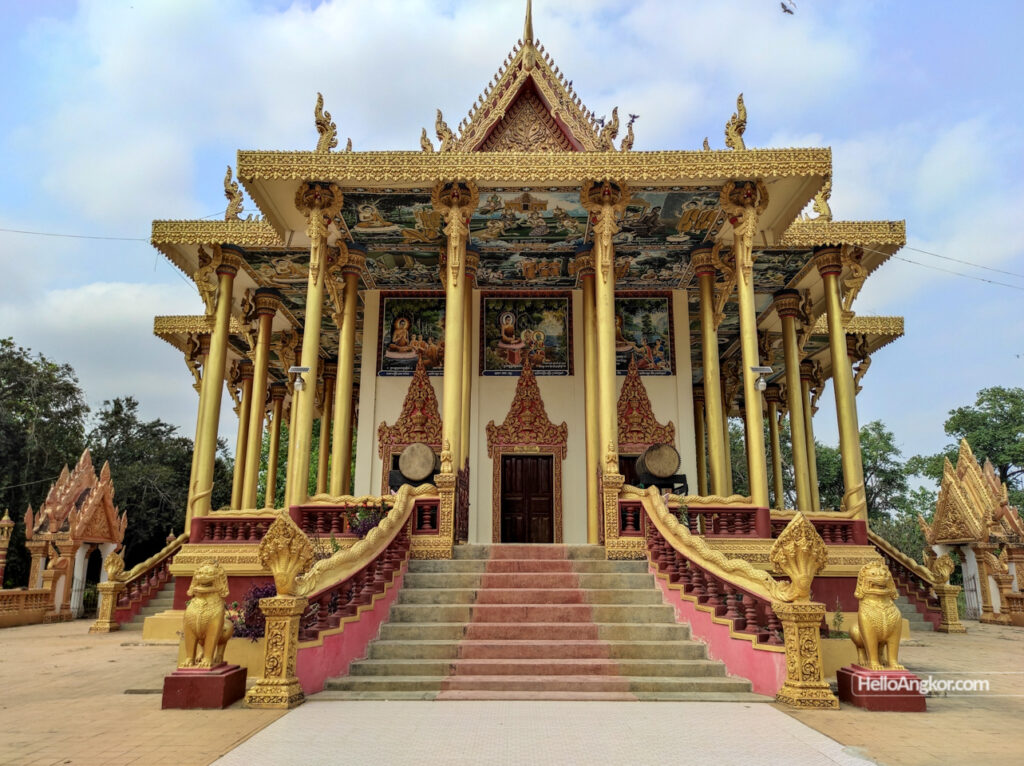
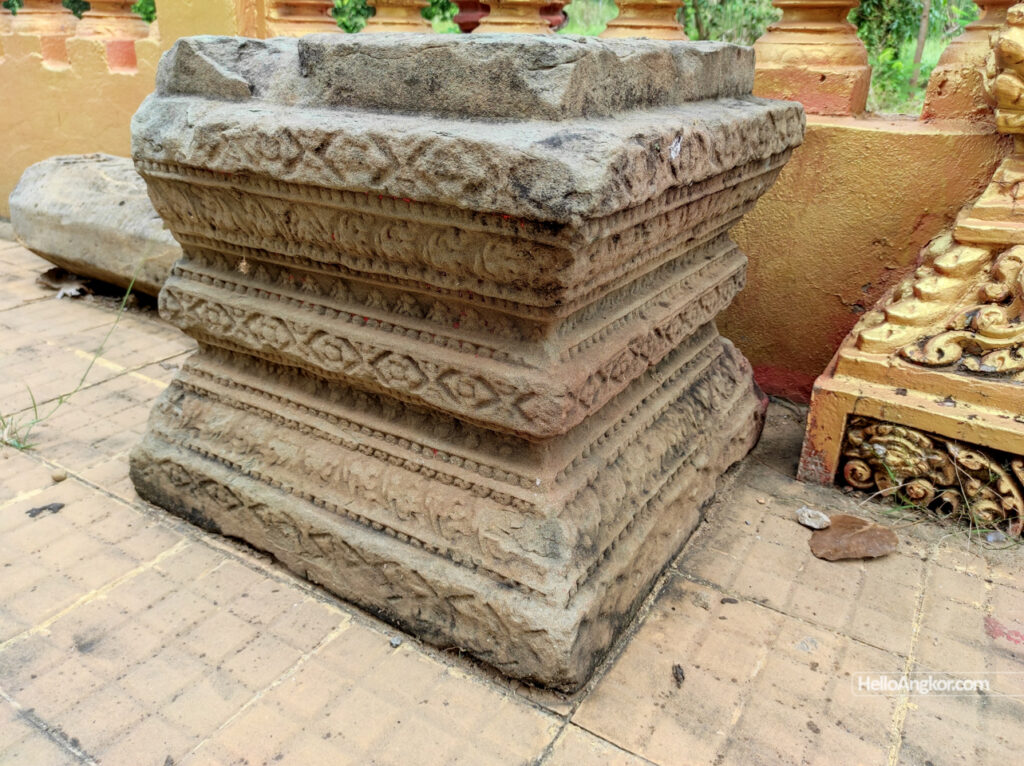
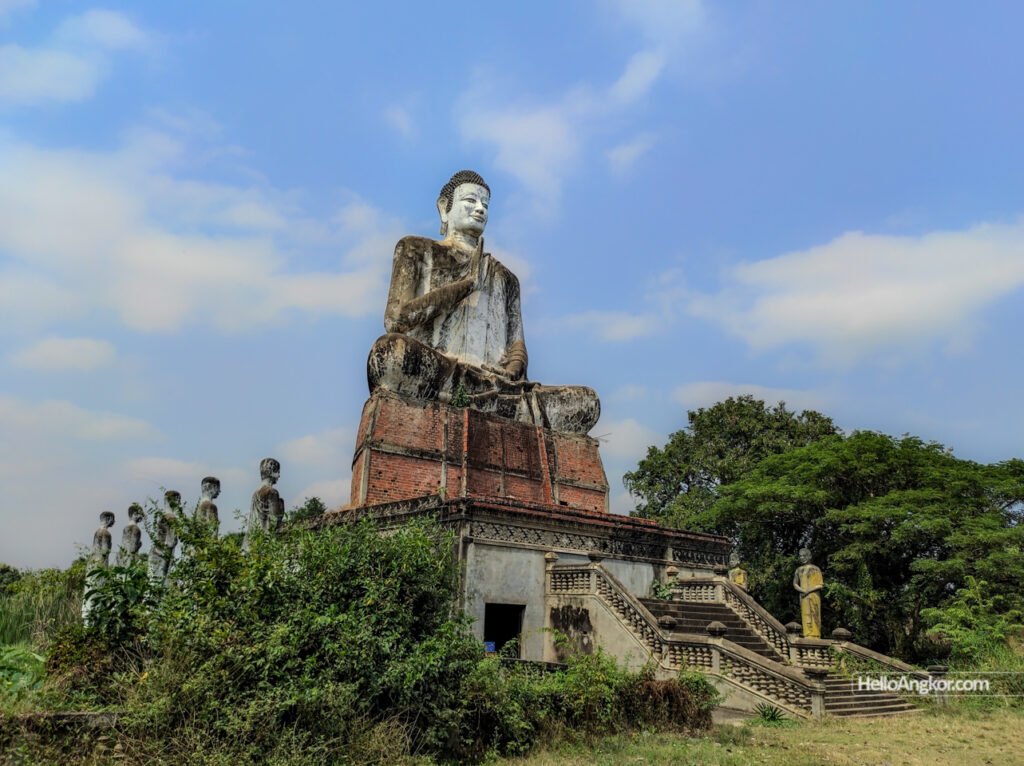
Photos from the 2017 visit
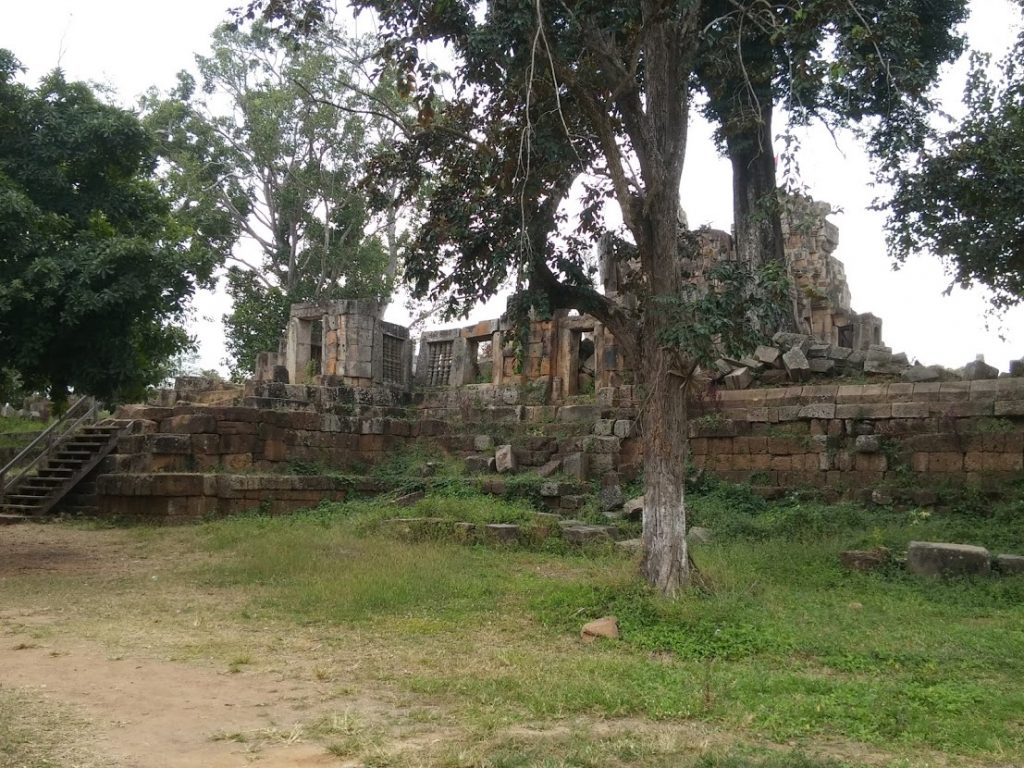
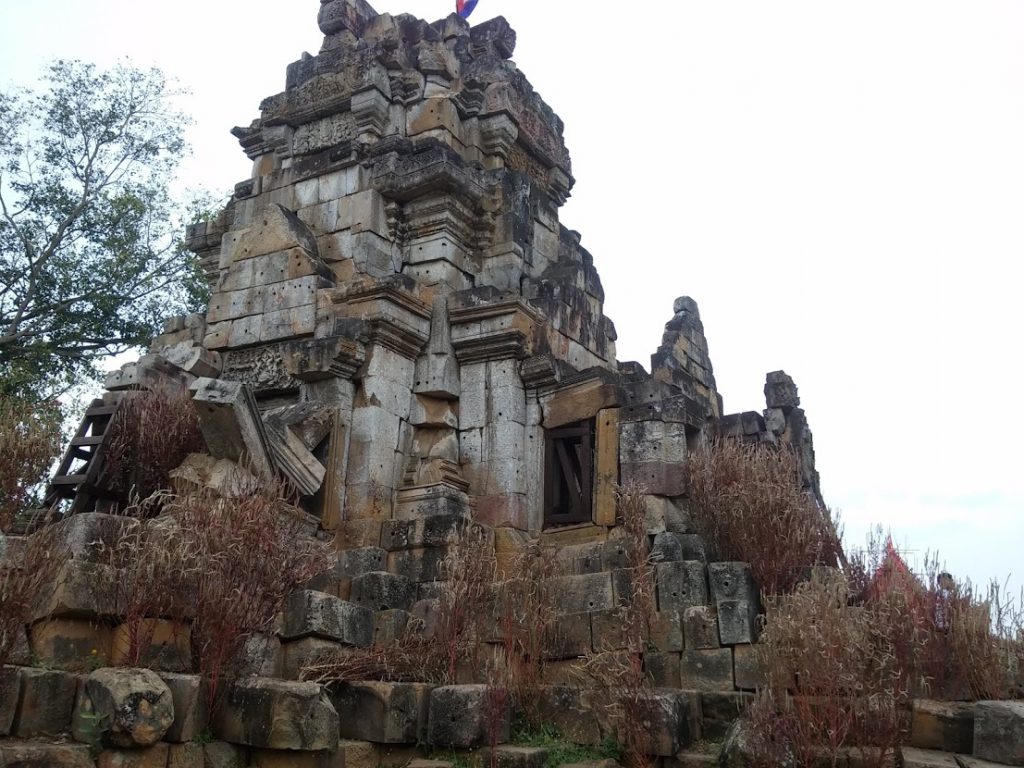
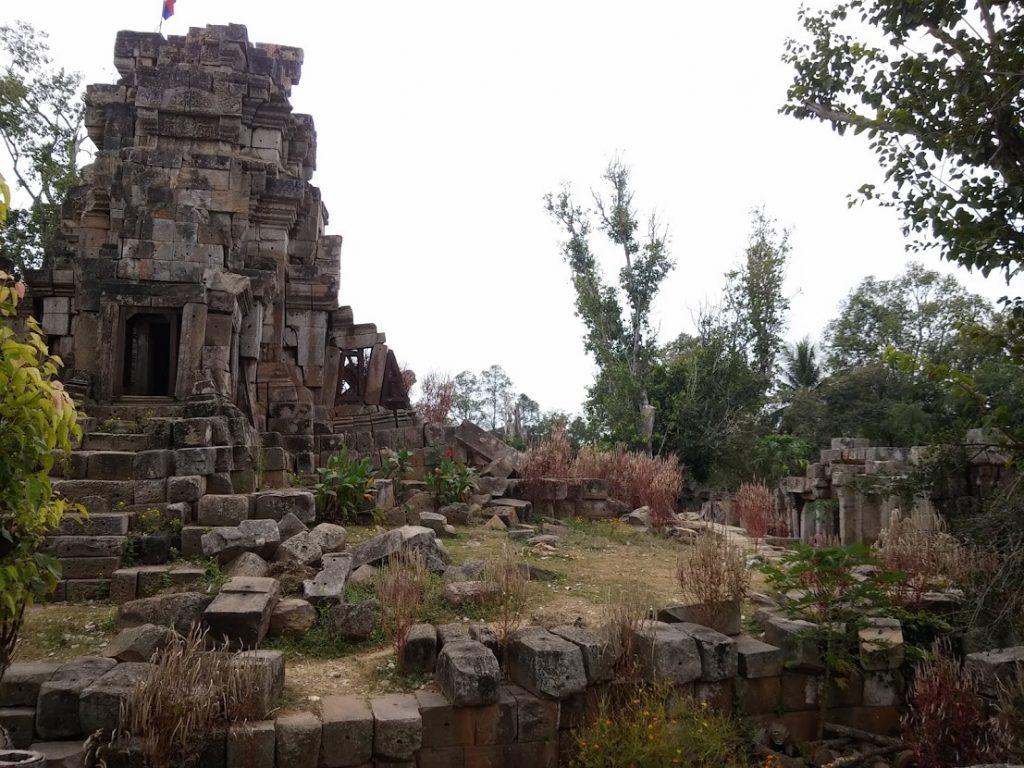
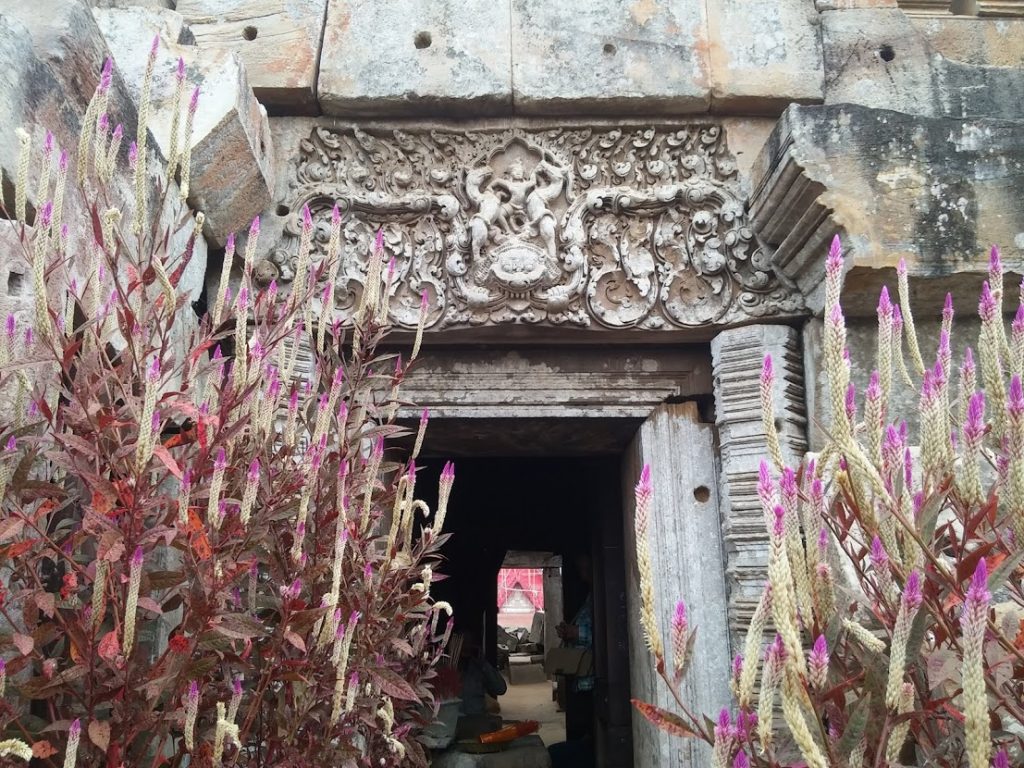
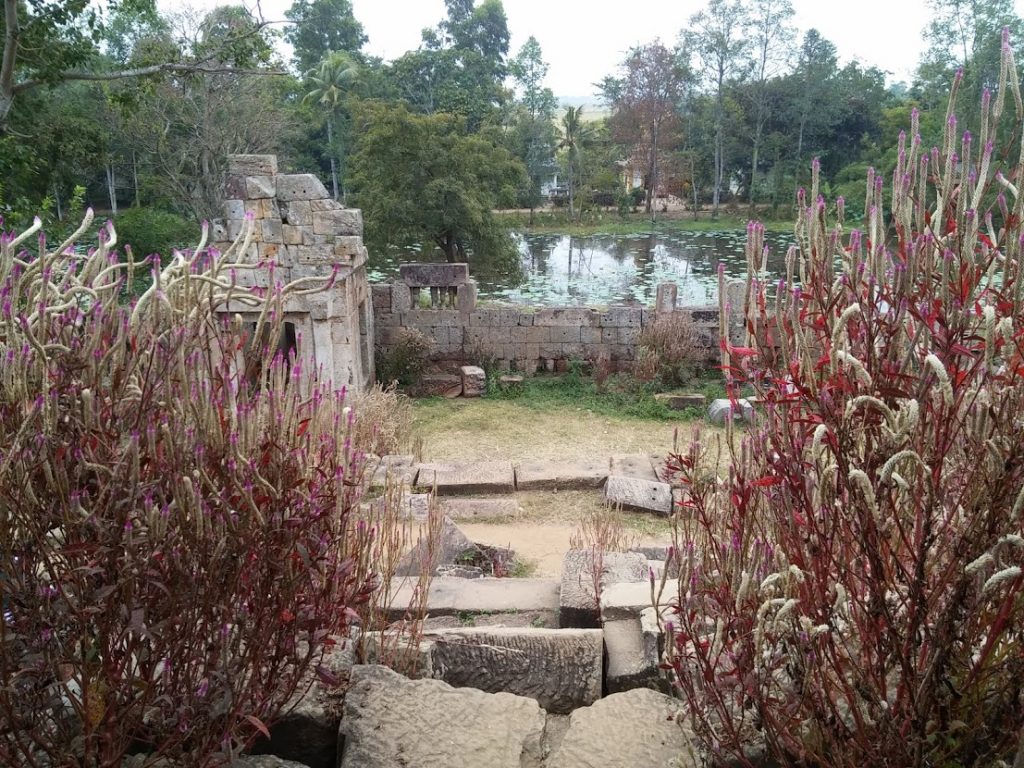

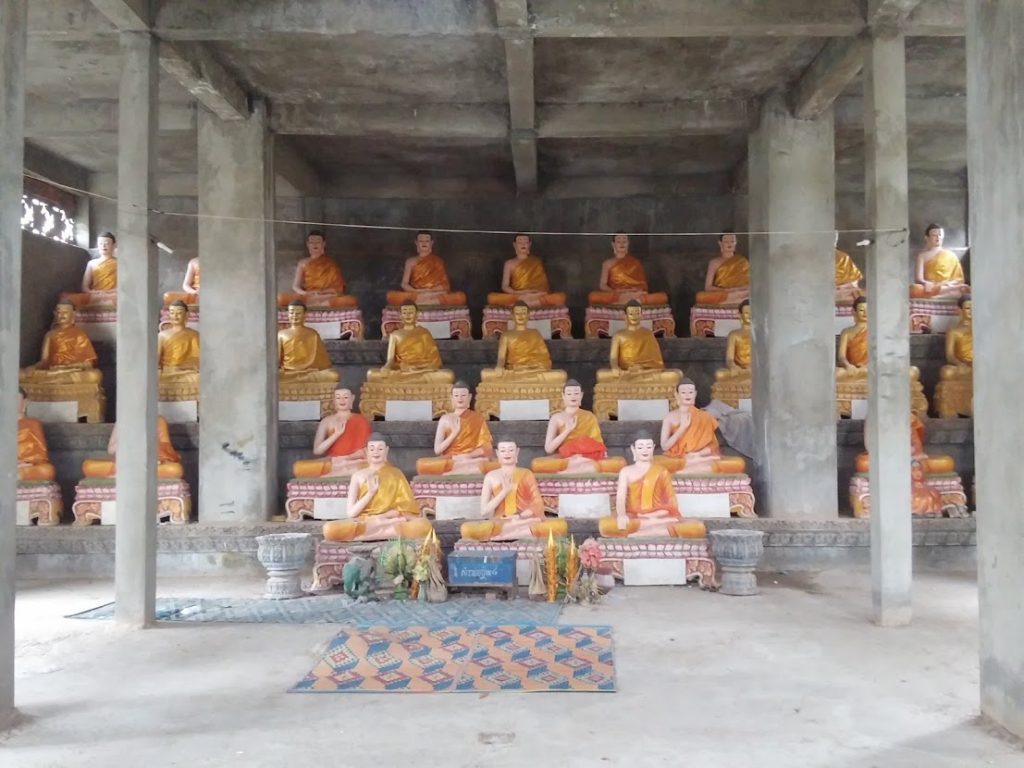

Site Layout (via EFEO)
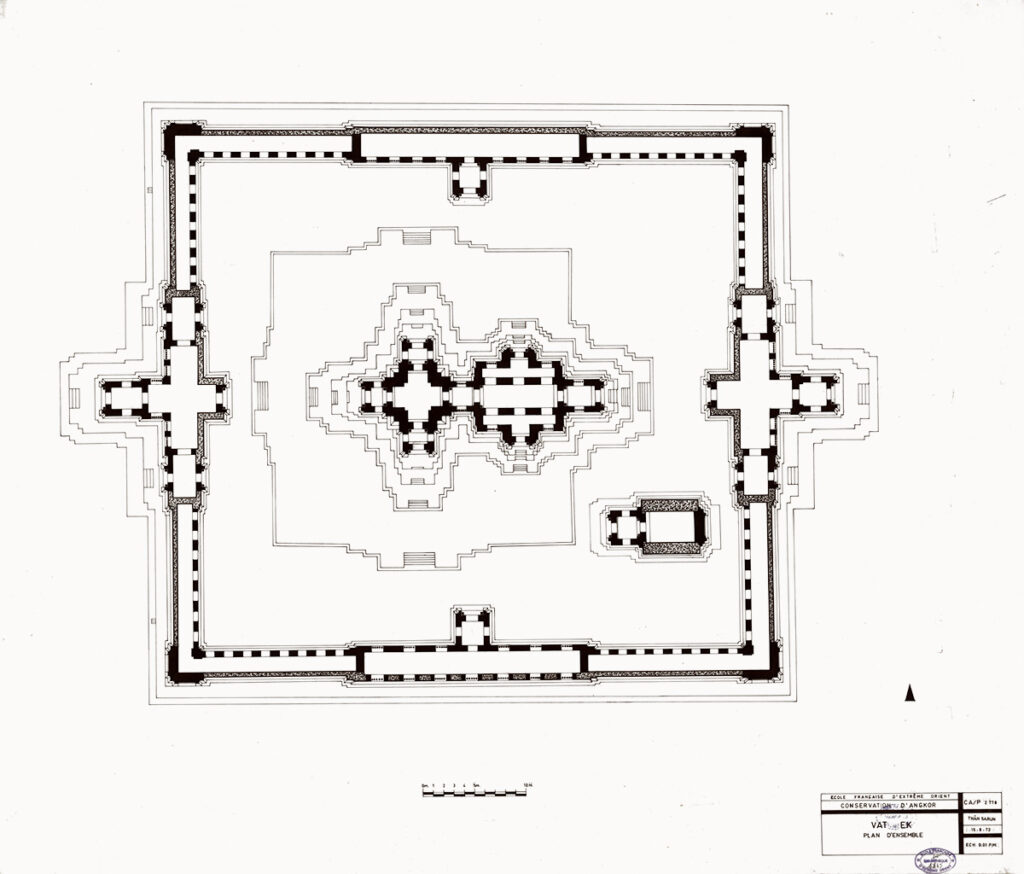
Historical Notes
Wat Ek. This pagoda of Vat Ek (the first) is – located about 8 kilometers to the N. of the citadel of Battambang, and 300 meters from the left bank of the Stung Sang Ke; its various buildings are grouped on the eastern facade of an ancient temple (fig. 109). It is a sandstone sanctuary, square, open on all four sides. exactly oriented by doors preceded by avant-corps. The main door, to the E., is preceded by a nave, also in sandstone, connected to the sanctuary by the avant-corps of this door and opening, itself, to the E., on a vestibule. This set of constructions forming the sanctuary is raised on a sandstone base with two tiers, 4 meters, which itself rests on a square terrace with a sandstone base wall, raised 2 meters and measuring approximately 32 meters on a side.
The interior hall of the sanctuary is cruciform, the branches departing from a square cella indicated by slight re-entrant angles. This cella is surmounted by a four-sided corbelled vault, interrupted by straight parts which correspond to the exterior tiers. It seems not to have been finished; at least it does not exceed the first step, at the present time, and one does not find, inside or outside, any of the bloes which would come from its partial collapse. The inner face of this vault is trimmed, which seems to indicate that there must not have been the ordinary wooden ceiling. As for the branches of the cross, they were covered by a kind of ceiling of planks on which the vault rests in part. Most of these planks, dried out but still solid, are in place, and where they are missing the upper blocks hold for balance.
The avant-corps of the N., O. and S. doors are lit on both sides by windows without railings-balusters; their two-sided corbelled vaults have not been erected or have collapsed; they lead to steep and narrow steps. The avant-corps E. which connects the sanctuary to the nave is also lit on both sides, but by windows with baluster bars: its vault is reduced to the first courses. It is the same for that of the nave and its own avant-corps which is almost completely ruined. This nave is widened by the addition of two aisles whose faces are pierced with projecting doors framed by windows with baluster bars; its side doors, like that of the vestibule, open onto steps. It must have been covered with a vault flanked by two half-vaults and as a result there is a double central colonnade where pieces of wood double the architraves.
The ornamentation of this sanctuary has been begun, but not finished; almost everywhere the small columns, which must have been octagonal and molded, have only been worked on four of their faces, between which there remains a flat surface outlined by the moldings.
The decorative lintels, of type III, are all in place, except those of the N., W. and S. avant-corps of the sanctuary, the side doors of the nave and the door of its avant-corps. That of the N. door of the sanctuary has as its central subject an image of Siva seated on Nandin with Parvati; that of the O. door, a figure of divinity mastering two monsters, lions by the posterior part of their body, horses by the forequarters; with the right hand resting on the chest, he pushes back the one on the right and holds the other by the bridle near the bit; the principal figure of the lintel of the S. door is that of Shiva dancing. The decorative lintel of the E. door represents the churning of the sea; the mount is represented here by a tree at the top of which is seated Brahmå on a blooming lotus, while a four-armed Visņu is hung on the throne; five people pull the head of the snake coiled around the tree to the right, five others are harnessed to its tail on the left; a frieze of nine figures seated on thrones runs along the top edge of the panel. This is, on the other hand, surmounted by a small pediment in the tympanum of which we see, in the center, a twisted tree on whose throne a squirrel climbs, and whose stylized foliage occupies the entire upper part; to the right of the tree, a figure with protruding eyes, split lips, large earrings hanging from his shoulders, is seated on the ground, facing the tree, one knee raised; behind fled is a woman in the same position; on the left and symmetrically placed, we see, first, a woman also seated on the ground; his head rests on his left hand, his elbow rests on his raised left knee; his right hand is placed on the ground; behind her is a cloud,
The decorative lintels of the side doors of the nave are adorned with figures of Indra on the three-headed elephant. That of the eastern door tale has as its main figure a character holding a lotus bud in his left hand; he is seated facing on a saddled elephant represented in profile; above, the group of Çiva and Párvati on Nandin, between an elephant on the left and a lion on the right, occupies the tympanum.
Ornamental motifs decorate the upper tiers of the sanctuary. A rough molding of cornices also runs on the interior face of the cruciform room, but all this decoration, moreover unfinished, is on the whole mediocre.
The ornamentation of the retaining walls of the basement and the terrace gave rise only to a few outlines of moldings on the porch of the nave. As for the terrace, in itself, it presents certain rather singular arrangements; it is in fact interesting to note that its normal development towards E. was interrupted to make way for the annex building, moreover irregularly placed in a lower courtyard. It has three steps corresponding to the N.. O. and S. doors of the sanctuary, in addition to the large step of the main passage to the E.
First enclosure. A wall of galleries determines around the sanctuary a courtyard which measures 52 meters internally in E.-W direction. over 49 meters in a N.-S. These galleries are formed externally by a solid limonite wall, with basement and cornices in sandstone, and internally by a sandstone facade pierced with numerous windows measuring o m. 86 wide and are separated by panels of 1 m. 05. They were to be seen, but this work has not been started; however sandstone domes have been sketched at the corners. The exterior facade was, no doubt, to receive moldings of cornices which were not started; as for the interior facade, it has no other decoration than the moldings framing its windows.
These galleries are interrupted on the E. and O. faces by gopuras with three passages: the central one crosses a cruciform room whose perpendicular branches are less developed than the axial branches; the exterior entrances are preceded by illuminated avant-corps; in addition, four windows open to the outside still light these rooms; the side passages simply pass through side rooms through opposite doors. These main buildings are in limonite for the full walls, with foundations, cornices and frames of the openings in sandstone; but all these parts remained raw and no ornamentation was begun. They were to be covered with two-sided vaults without domes which also remained at the project stage.
The N. and S. galleries are widened in their central parts, to form private rooms which only open onto the interior courtyard, in which their interior facades, equipped with a median door, protrude. That of the S. is lighted only by daylights, out of reach, and defended by bars-balusters. They are, in construction, identical to the gopuras, and, as for these. the decorating work didn’t even begin. not been
Annex building. It is the same for the annex building regularly placed and oriented in the S. E. corner of the courtyard. The door open to the W, while a false door cut in a sandstone veneer decorates the E face, is preceded by a front part lit on its two faces.
The vault has not been pushed above the straight parts which rest on the end of the side half-vaults; we notice in these straight parts which are in sandstone, the beginning of the work of the bars-balusters which were not turned, but cut in a block of sandstone by a series of lozenges.
All of these constructions rest on a slightly overhanging terrace, which is formed by a limonite basement wall, 2 m high. 10, with two perrons attached to the exterior doors of the gopuras.
A basin-ditch 35 meters wide surrounds this terrace, with two access roads about thirty meters wide to the E. and at O. Finally, in an altar of neak ta on the E. floor, are gathered, with sandstone lions, fragments of statues including a head of a divinity with a high cylindrical bun surrounded, at the base, by a bracelet of pearls and previously decorated of a figure of the Buddha.
Inventaire descriptif des monuments du Cambodge, E. Lunet de Lajonquière, 1902
Inscription
- K. 211 – door jamb – Khmer text and 11 lines of Sanskrit – IC III, p. 26
The two jambs of the eastern door of the Våt Èk sanctuary, 8 kilometers north of Battamban, each bear a Khmer inscription. That of the southern abutment, which was not reproduced in the Corpus, comprised five lines of which only a few characters remain: we recognize the name of V. K. A. Yogiçvarapandita, author of the inscription of the northern abutment. This one, very well preserved, consists of nine lines in Khmer, followed by two Sanskrit lines forming two çloka. Like the Våt Båsět inscriptions, it dates from the reign of Suryavarman I. V. K. A. Yogiçvarapandita, to whom the king bestowed the title of dedrya sthdpaka, had founded in Narendragrāma a linga bearing the name of Suryavarmeçvara (at least this is what seems to result from the first Sanskrit cloka). In 959 c. (1037 A. D.), he offered to this sanctuary, which must be none other than that of Våt Ek, various precious objects and affected the revenues of the country of Jägrāma to the maintenance of the cult. On this occasion, he makes the usual recommendations concerning the maintenance of his foundation, and indicates the limits of the domain. The Sanskrit text simply mentions the gift of a golden vessel, with a short eulogy of the donor.
Yogiçvarapandita, from the country of Vnur Kamdvät in the territory of Vyadhapura, is named in the inscriptions of Prasát Tà Kêv as the guru of Suryavarman I, and as “the executor of the works of the king who completed the Hemagiri”, that is to say precisely the monument of Tà Kèv. One of these inscriptions mentions the foundation of Narendragräma, i.e. Våt Ek.
Inscriptions Du Cambodge, George Coedes
Map
Site Info
- Site Name: Ek [Phnom] (V.) Khmer Name: វត្តឯក(ភ្នំ)
- Reference ID: HA11418 | Posted: January 18, 2021 | Last Update: May 22nd, 2023
- Other Names: Ek Phnom Pagoda, វត្តឯកភ្នំ
- Tags/Group: 11th Century, ra, Temples, Wat
- Location: Battambang Province > Aek Phnum District > Peam Aek Commune > Ta Korm Village
- MoCFA ID: 89
- IK Number: 861
- Inscription Number/s: K. 211

